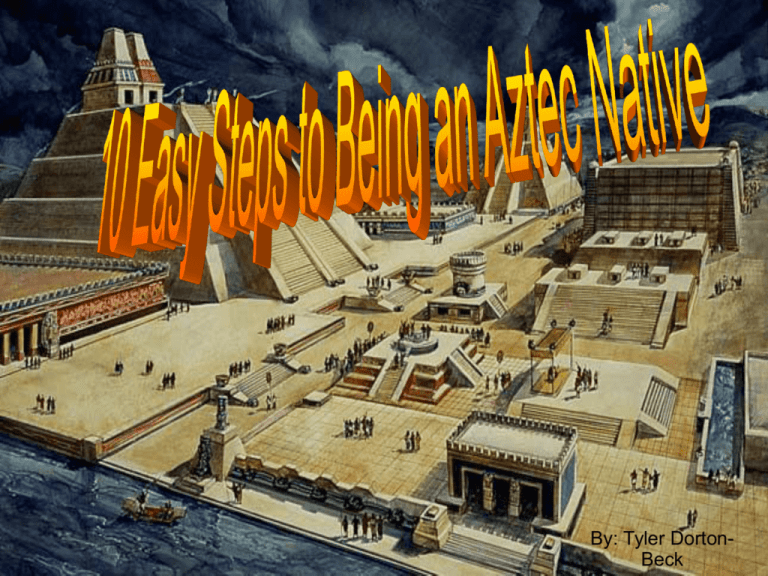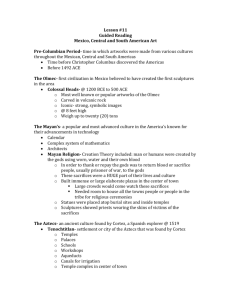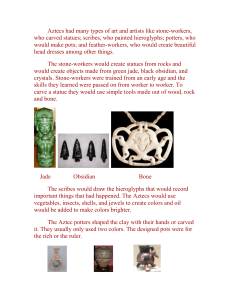10 Easy Steps to Being an Aztec - bkind2animals
advertisement

By: Tyler DortonBeck The Aztecs were a nomadic tribe who arrived in northern Mexico some time near the beginning of the 13th century. They had a complex social, religious, political, artistic, and commercial life. Aztec women used to wear a skirt wrapped around their hips and waist with a robe or shirt over their top half. The men would wear loincloths with a sleeveless cloak or poncho on top. The Aztecs were mainly composed, in the art world, of stone workers, scribes, potters, and feather workers. Stone workers would make statues to honor their gods and royalty using black obsidian, transparent crystals, green jade, and other rare and common stones. They are trained young and the skills, techniques, and teachings were passed down from each generation to the next. Scribes would draw pictograms for record keeping. They would first create a sketch of the image then add further details. They would make colors using vegetables, insects, shells, and minerals. The Aztecs would also use oil to brighten the colors. The Aztec potters would create pottery. They would shape the clay with their hands or carve it. They would often only use two colors when decorating the pottery. This art was only in the possession of royalty and rich. Feather workers would take the feathers of exotic birds and weave them into headdresses, robes, or other clothing for the rich. The Aztec doctors mainly used herbal remedies to treat the ill. These were used for both treatment and prevention. They had wide knowledge of the human body. Cures for many diseases were discovered by them. They had a large amount of bodies to practice on due to wars and the many sacrifices they held. Temples that the Aztecs made didn’t always please them. Instead of breaking down and building again, they would build on top of the old temples. Temples were mainly held for the sacrifices that will be expanded on later. Royalty homes were extravagant and beautiful. The base would consist of large rooms with pillars supporting the rest of the structure. Each room had its own purpose. The homes of citizens were made of adobe (dirt, clay, and water). They did not have separate rooms but instead had on room with different sections to meet different needs. The Aztecs were a polytheistic society. This means that they believed in multiple gods (like Huitzilopochtli, Toltec, and Quetzalcoatl). They also believed that human sacrifice was the most precious way they could please these gods, since life is the most valued possession. They would practice these sacrifices in elaborate temples of the gods. Approximately 20,000 humans were sacrificed each year by the Aztecs. Many other societies located near the Aztecs did not agree with their way of life. The main reason for debate was the sacrifices. But in 1428, the Aztecs formed a three-way alliance with the Texcocans and the Tacubans. This act was in an attempt to overthrow their greatest common enemy: the Tepanec. By the early 16th century, up to 500 small states were under the control the Aztecs. The Aztec calendar was a quite advanced one for its time period. It consisted of 365 days in its solar cycle and had a ritual cycle of 260 days. This played a great role and had much influence on the religion and rituals. The Aztecs had a strict cast system. At the bottom of the hierarchy were serfs, indentured servants, and slaves. Higher up were commoners. The next level consisted of merchants. Next were lords and nobles. The top of the social hierarchy for the Aztecs had the royalty. www.history.com library.thinkquest.org clio.missouristate.edu /library.thinkquest.org






